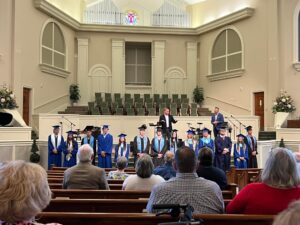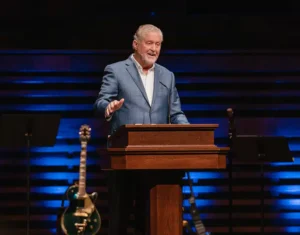
WAKE FOREST, N.C. (BP)–The return of the Southern Baptist Convention to the faith of its fathers came full circle at Southeastern Baptist Theological Seminary in Wake Forest, N.C, May 17, when the seminary’s elected faculty lined up to sign the Baptist Faith and Message during the annual Awards Chapel.
Acting voluntarily to endorse the SBC statement of faith, the faculty ordered itself behind President Paige Patterson and the dean of the faculty, Russ Bush.
In an introduction to the signing, Bush affirmed to Patterson and to the packed auditorium of the campus chapel, “The current faculty voluntarily wishes to make a testimony to you and to one another and to our Southern Baptist Convention that we stand with them and with you on these essential doctrines.”
Many on the faculty, like Keith Eitel, professor of Christian missions and director of the Center for Great Commission Studies, had wanted to sign the document on Sept. 13, 2000, the day they unanimously affirmed the BFM by raised hands during a faculty meeting, but Patterson had asked them to wait until the trustees made official provision for the signing.
Eitel, who understood Patterson’s thinking but was disappointed at the delay, said, “I felt it would be good to show solidarity with the BFM 2000 and our colleagues at the other SBC seminaries and institutions as quickly as possible.”
The trustees made that provision at their April meeting when they approved a bylaw change which required all new faculty to sign both the Abstract of Principles, Southeastern’s longstanding faith statement, and the Baptist Faith and Message.
Elected faculty at Southeastern have signed the Abstract of Principles since the seminary’s founding in 1950.
Southeastern and Southern Baptist Theological Seminary in Louisville, Ky., historically have followed the Abstract of Principles while the other four SBC seminaries have adhered to the Baptist Faith and Message.
Prior to the approval of the change to the bylaw, Southeastern’s trustees extensively discussed how to implement the Baptist Faith and Message without tarnishing the school’s long history of signing the Abstract. After considering many options, the trustees settled on requiring future elected faculty to sign both. Bush confirmed to the trustees that the two documents are not contradictory but rather strengthen one another.
Patterson, speaking to the May 17 gathering, said, “In 1978, there began a movement in the Southern Baptist Convention to attempt to do what had never before taken place in Christian history of 2000 years, and that was to restore a drifting denomination to the faith of its fathers.”
Speaking of the SBC’s free church tradition, Patterson continued, “Our founding fathers of our Southern Baptist Convention saw to it that the churches remained autonomous from the convention itself and from each other so that their accountability was directly to God, and then they would cooperate together to do the Lord’s work. That voluntary cooperation is a signal phenomenon even today.”
The voluntary cooperation was not based on autonomy alone, Patterson said, “but a portion of that [cooperation] was also based on the fact that we had a strong confidence in the reliability of the Word of God. That confidence was really the rule that kept us all together.”
Patterson recounted that “we made an attempt to amend the Baptist Faith and Message [during his presidency of the SBC] so as to strengthen it and to return it to the strong document it once was when it was the New Hampshire Confession of Faith and then the Baptist Faith and Message of 1925.”
Patterson also clarified a common misconception concerning the statements of faith. “Now, of course, any one of us, if we were setting out to write this would write it a little differently. What a statement of faith like this is supposed to be is a statement of those things that are most commonly believed among us.” As an example, Patterson noted that he was premillenial in his eschatology and believes in a pretribulation rapture, neither of which made it into the BFM as adopted by the SBC in June 2000.
For the faculty of Southeastern, the proof is in the Great Commission, Eitel said. “What we are trying to produce here is scholarship on fire with missions and evangelism,” he noted. Following the signing, the faculty commissioned and prayed over more than 200 students and their family members who were embarking on missions initiatives, some for two years, to take the gospel to the ends of the earth.
Choking back tears and with broken voice, Patterson called on God to crown the students’ evangelistic efforts with success and to give special protection to the little children, the MKs (missionary kids) who will grow up on foreign soil.
–30–















